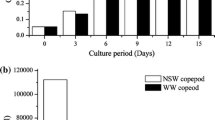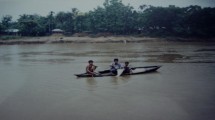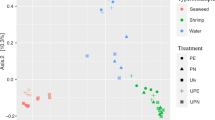Abstract
The present work aimed to explore the efficacy of microbial cocktail of microalgae-associated bacteria, such as Alteromonas sp. Mab 25, Labrenzia sp. Mab 26, Marinobacter sp. Mab 18 and Marinobacter sp. Mab 34, on survival, growth and metamorphosis rate (zoea to mysis) of Indian white shrimp larvae, Penaeus indicus. The microbial cocktail was found to be having a stimulatory effect on microalgal growth. Further, from zoea I to mysis I, P. indicus larvae were fed in triplicate: (1) non-axenic Isochrysis galbana, (2) axenic I. galbana, (3) non-axenic I. galbana enriched with an added microbial cocktail and (4) axenic I. galbana enriched with an added microbial cocktail. All measurements (survival, growth and metamorphosis rate) were highest in non-axenic I. galbana enriched with microbial cocktail and lowest in axenic I. galbana (p < 0.01). This study stands as first one of its kind involved in practical application of microalgae-associated bacteria to produce more efficient live feeds, which might greatly enhance the productivity of larviculture in aquaculture. Our results signify that ‘microbial cocktail’ developed from the selected microalgae-associated bacteria would be effective in the healthy larval rearing of aquaculture species. Thus, the concept proved in the present work can be further developed as an application package in commercial shrimp hatcheries.

Similar content being viewed by others
References
Amin SA, Parker MS, Armbrust EV (2012) Interactions between diatoms and bacteria. Microbiol Mol Biol Rev 76:667–684
APHA (American Public Health Association) (2005) Standard methods for the examination of water and wastewater. Public Health Association, Washington, DC
Arora M, Anil AC, Delany J, Rajarajan N, Emami K, Mesbahi E (2012) Carbohydrate-degrading bacteria closely associated with Tetraselmis indica: influence on algal growth. Aquat Biol 15:61–71
Avendano-Herrera RE, Riquelme CE (1999) Establishment of mixed-culture probiotics and microalgae as food for bivalve larvae. Aquac Res 30:893–900
Boussiba S, Sandbank E, Shelef G, Cohen Z, Vonshak A, Ben-Amotz A, Arad S, Richmond A (1988) Outdoor cultivation of the marine microalga Isochrysis galbuna in open reactors. Aquaculture 72:247–253
Conceição LEC, Yúfera M, Makridis P, Morais S, Dinis MT (2010) Live feeds for early stages of fish rearing. Aquac Res 41:613–640
D’Souza FM, Loneragan NR (1999) Effects of monospecific and mixed-algae diets on survival, development and fatty acid composition of penaeid prawn (Penaeus sp.) larvae. Mar Biol 133:621–633
Das P, Mandal SC, Bhagabati SK, Akhtar MS, Singh SK (2012) Important live food organisms and their role in aquaculture. In: Sundaray JK, Sukham M, Mohanty RK, Otta SK (eds) Frontiers in Aquaculture. Narenda Publishing, New Delhi, pp 69–86
De Kluijver A, Soetaert K, Schulz KG, Riebesell U, Bellerby RGJ, Middelburg JJ (2010) Phytoplankton-bacteria coupling under elevated CO2 levels: a stable isotope labelling study. Biogeosciences 7:3783−3797
Farzanfar A (2006) The use of probiotics in shrimp aquaculture. FEMS Immunol Med Microbiol 48:149–158
Fuentes JL, Garbayo I, Cuaresma M, Montero Z, González-Del-Valle M, Vílchez C (2016) Impact of microalgae-bacteria interactions on the production of algal biomass and associated compounds. Mar Drugs 14:100
Harrison PJ, Berges JA (2005) Marine Culture media. In: Andersen RA (ed) Algal culturing techniques. Elsevier Academic Press, London, pp 21–34
Jamali H, Ahmadifard N, Abdollahi D (2015) Evaluation of growth, survival and body composition of larval white shrimp (Litopenaeus vannamei) fed the combination of three types of algae. Int Aquat Res 7:115–122
Khojasteh Z, Davoodi R, Vaghei RG, Nooryazdan H (2013) Survival, development and growth of whiteleg shrimp, Litopenaeus vannamei zoea fed with monoalgae (Chaetoceros and Tetraselmis) diets. World J Fish Mar Sci 5:553–555
Liu CH, Chiu CS, Lin PL, Wang SW (2009) Improvement in the growth performance of white shrimp, Litopenaeus vannamei, by a protease-producing probiotic, Bacillus subtilis E20, from natto. J Appl Microbiol 107:1031–1041
Moal J, Samain JF, Corre S, Nicolas JL, Glynn A (1996) Bacterial nutrition of great scallop larvae. Aquac Int 4:215–223
Muller-Feuga A (2004) Microalgae for aquaculture: the current global situation and future trends. In: Richmond A (ed) Handbook of microalgal culture: biotechnology and applied phycology. Blackwell, Oxford, pp 352–364
Nair AV (2016) Bioprospecting of novel antimicrobial metabolites from Bacillus subtilis MBTDCMFRI Ba37 and Pseudomonas aeruginosa MBTDCMFRI Ps04 of tropical estuarine habitats of Cochin, India and its application in fish health management. PhD Dissertation, Cochin University of Science and Technology
Natrah FMI, Bossier P, Sorgeloos P, Yusoff FM, Defoirdt T (2014) Significance of microalgal-bacterial interactions for aquaculture. Rev Aquac 6:48–61
Nicolas JL, Corre S, Cochard JC (2004) Bacterial population association with phytoplankton cultured in a bivalve hatchery. Microb Ecol 48:400–413
Okauchi M, Kawamura K, Mizukami Y (1997) Nutritive value of ‘Tahiti Isochrysis’ Isochrysis sp. for larval greasy back shrimp, Metapenaeus ensis. Bull Natl Res Inst Aquacult 26:1–11
Preetha K (2017) Phenetic characterization, molecular phylogeny, and bioprospecting of selected saline microalgae from Indian subcontinent. PhD Dissertation, Cochin University of Science and Technology
Rafiee G, Pourbabaee A, Agharokh A, Avakhkeysami M (2014) Effects of the mixed probiotic microalgae-bacteria, Skeletonema costatum-Bacillus subtilis, on stress tolerance and innate immunity prophenoloxidase (proPO) activating in Penaeus monodon larvae. J Biol Environ Sci 4:273–284
Rajapitamahuni S, Bachani P, Sardar RK, Mishra S (2019) Co-cultivation of siderophore-producing bacteria Idiomarina loihiensis RS14 with Chlorella variabilis ATCC 12198, evaluation of micro-algal growth, lipid, and protein content under iron starvation. J Appl Phycol 31:29–39
Salvesen I, Reitan KI, Skjermo J, Øie G (2000) Microbial environments in marine larviculture: impacts of algal growth rates on the bacterial load in six microalgae. Aquac Int 8:275–287
Sandhya SV, Vijayan KK (2019) Symbiotic association among marine microalgae and bacterial flora: a study with special reference to commercially important Isochrysis galbana culture. J Appl Phycol 31:2259–2266
Sandhya SV, Preetha K, Nair AV, Antony ML, Vijayan KK (2017) Isolation, characterisation and phylogenetic diversity of culturable bacteria associated with marine microalgae from saline habitats of South India. Aquat Microb Ecol 79:21–30
Sapp M, Schwaderer AS, Wiltshire KH, Hoppe HG, Gerdts G, Wichels A (2007) Species-specific bacterial communities in the phycosphere of microalgae? Microb Ecol 53:683–699
Schwenk D, Nohynek L, Rischer H (2014) Algae−bacteria association inferred by 16S rDNA similarity in established microalgae cultures. Microbiol Open 3:356–368
Acknowledgements
We wish to thank Dr. A. Gopalakrishnan, Director, ICAR-Central Marine Fisheries Research Institute (CMFRI), and to Dr. P. Vijayagopal, Head of the Division, Marine Biotechnology Division, ICAR-CMFRI, for their generous encouragements.
Funding
This work was supported by the Kerala State Council for Science, Technology and Environment (KSCSTE), Govt. of Kerala (No. 001/FSHP/11/CSTE).
Author information
Authors and Affiliations
Corresponding author
Ethics declarations
Conflict of interest
The authors declare that they have no conflict of interest.
Additional information
Publisher’s note
Springer Nature remains neutral with regard to jurisdictional claims in published maps and institutional affiliations.
Rights and permissions
About this article
Cite this article
Sandhya, S.V., Sandeep, K.P. & Vijayan, K.K. In vivo evaluation of microbial cocktail of microalgae-associated bacteria in larval rearing from zoea I to mysis I of the Indian white shrimp, Penaeus indicus. J Appl Phycol 32, 3949–3954 (2020). https://doi.org/10.1007/s10811-020-02230-0
Received:
Revised:
Accepted:
Published:
Issue Date:
DOI: https://doi.org/10.1007/s10811-020-02230-0




